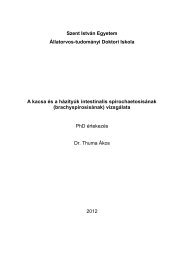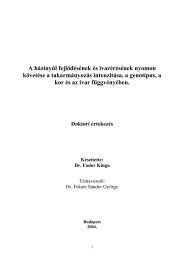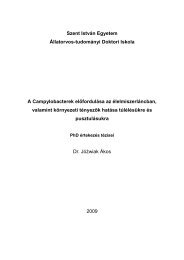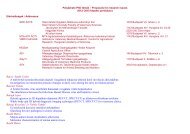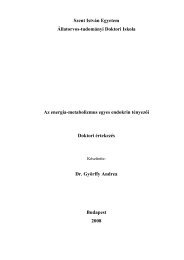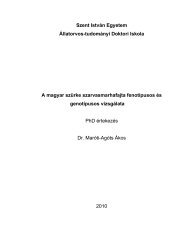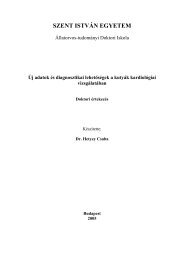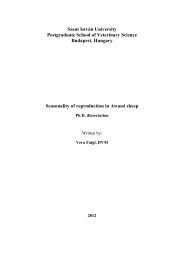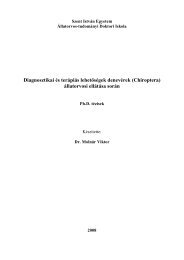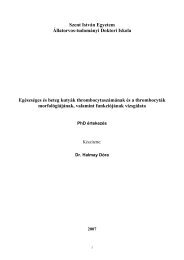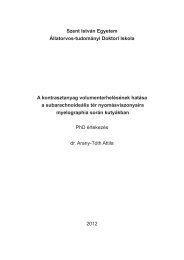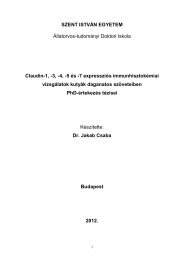Jánosi - Állatorvostudományi Doktori Iskola - Szent István Egyetem ...
Jánosi - Állatorvostudományi Doktori Iskola - Szent István Egyetem ...
Jánosi - Állatorvostudományi Doktori Iskola - Szent István Egyetem ...
Create successful ePaper yourself
Turn your PDF publications into a flip-book with our unique Google optimized e-Paper software.
2. Summary<br />
The author carried out the comparative examination of H. somni strains isolated from farm animals.<br />
She collected 652 swab samples in 9 cattle- and 10 goat flocks of Hungary then isolated 56 bacterial<br />
strains identified as H. somni on the basis of cultural, morphological and biochemical<br />
characteristics. H. somni was found to be present in 10-40% on the genital mucous membranes of<br />
cattle, the isolation rate increased from 40% to 90% during a four-time, monthly sampling of 20<br />
heifers. She reported the first isolation of H. somni from goats.<br />
One hundred H. somni strains from fresh clinical isolates and from the culture collection of<br />
Department of Microbiology and Infectious Diseases (<strong>Szent</strong> <strong>István</strong> University, Faculty of<br />
Veterinary Science, Budapest, Hungary) were included in the examinations.<br />
Using the BIOLOG MICROSTATION ID SYSTEM she identified the H. somni strains on the basis of<br />
the utilisation 95 single carbon sources. The system identified 83% of the examined bacterial strains<br />
as H. somni. Compared to the results of 15 H. somni identified by partial amplification of 16S<br />
rDNA, false negative but no false positive ones could be found.<br />
Analysing the metabolic fingerprints of H. somni strains there were two carbon sources – dextrin<br />
and α-D-glucose – that could be utilised by all of the strains. In the case of bovine vaginal isolates<br />
the 100% utilisation ability of D, L-lactic acid was a typical characteristic of the group as well as D-<br />
mannose and turanose were in the case of H. somni strains isolated from sheep.<br />
Studying the relationships of 100 H. somni strains on the dendrogram based on their carbon source<br />
utilisation, she found several highly similar strains as well as different ones in certain cattle and<br />
sheep flocks. She proved the presence of two persistent respiratory isolates in a cattle stock.<br />
Analysing the cumulative results of pulsed field gel electrophoresis (PFGE) she also confirmed the<br />
presence of similar, different and persistent H. somni strains in certain cattle and sheep flocks.<br />
Comparing the results of metabolic fingerprinting and PFGE, the methods completed well each<br />
other. She adopted the first time the examination of carbon source utilisation for epidemiological<br />
characterisation of H. somni strains.<br />
For studying the clinical and pathological effect of H. somni in calves an aerosol infection method<br />
closely resembling the natural way of infection was developed. She applied the method successfully<br />
in infecting calves. Pathological examination of infected and control groups showed catarrhal<br />
bronchopneumonia in all animals, thus histopathological examination to complete pathological<br />
results and evaluate the efficacy of the trial was recommended. In the control group no H. somni<br />
was isolated in contrast the 100% detection rate in infected groups. She characterised the first time<br />
in Hungary the pathological and histological findings of H. somni infected calf lungs.<br />
10



